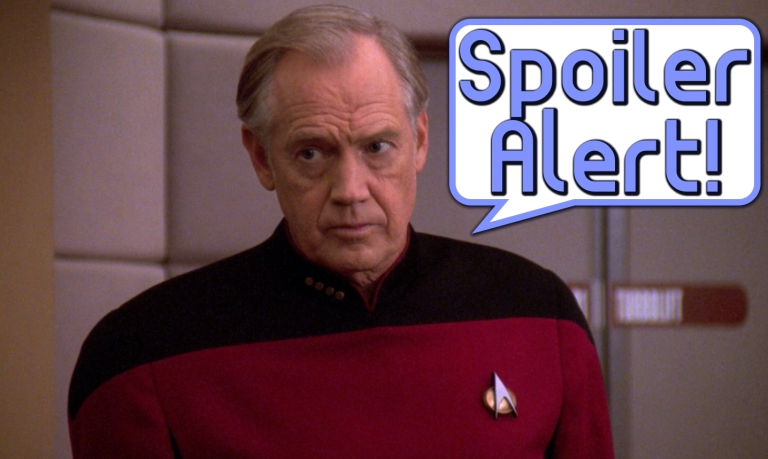
Spoiler Warning: There are spoilers ahead for Star Trek: Discovery Seasons 1-4 and Star Trek: Picard Season 1.
Sorry for being a few days late with this review! I had several other things going on this week, including my big end-of-year article, a piece looking ahead to 2022’s entertainment experiences, and finally a review of The Matrix Resurrections that I worked very hard on. I also hoped to get around to a review of the new Disney film Encanto, but that ended up taking a back seat along with this review of Discovery’s mid-season finale.
As I said last week, I wasn’t exactly thrilled with the way the mid-season break was announced. Doing so on such short notice adds to a growing sense that ViacomCBS and Paramount+ are being very poorly-managed, and while I don’t begrudge the creative team taking additional time to work on or rework episodes in the second half of the season if that work needs to be done, it raises some serious questions about the handling of the Star Trek franchise and the Paramount+ streaming service on the corporate side of things. If ViacomCBS truly aims to compete with the biggest names in streaming, nonsense like this has to stop. In addition, there are still many Trekkies and would-be viewers all around the world who can’t watch Discovery due to corporate bullshit, something else that ViacomCBS needs to fix as quickly as possible.

But To Connect worked well as a mid-season finale. It was tense and had moments of high drama that demonstrated beyond any doubt that science fiction doesn’t need to drown in space battles and high-octane action to be exciting. It was also an episode that, unfortunately, made some of its moments of drama feel incredibly contrived.
After everything Michael Burnham went through in her rollercoaster relationship with Ash Tyler in Seasons 1 and 2, giving her the chance to settle down with someone like Book was an incredibly welcome change. Forcing them to go against each other – especially for a central reason that felt contrived in the extreme – would not have been my choice for the direction of their relationship. Discovery has, over the course of its three-and-a-half seasons thus far, felt a need to inject extra drama and extra conflict where none was needed, upping the character stakes to near-soap opera levels at times. Forcing Book and Burnham to work against each other is the latest example of this trend – and it’s a disappointing thing to see.
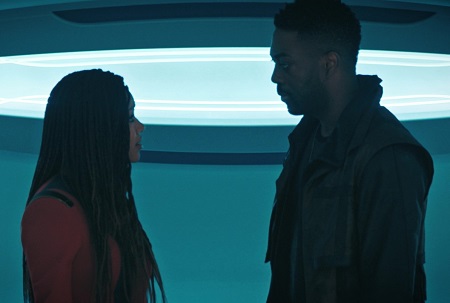
Book fell under the influence of Ruon Tarka, someone who we’ll have to deal with in more detail in a moment. For now, suffice to say that Tarka pounced on Book’s emotionally compromised state, seemingly manipulating him to advocate for attacking and destroying the DMA instead of pursuing peaceful first contact with whomever created it. Tarka has his reasons for doing this – claiming he wants to preserve the DMA’s power source so he can use it for his own purposes.
Book was clearly not thinking logically – and given his grief and the external prodding by Tarka, that makes sense. But the idea that Burnham couldn’t help him push through that, especially given that the DMA is explicitly stated to not be an immediate threat to anyone, is the point that begins to stretch credulity and make this whole situation feel contrived and forced.

Here’s the central point: the DMA, despite its potential danger and raw power, hasn’t actually done that much damage. If we assume that Discovery Season 4 has taken place over at least a couple of months of in-universe time, which seems reasonable given how long some of the scientists seem to have been working on these problems, it’s destroyed precisely two places in that time – a rate of one per month. And aside from Kwejian, the only other place we know it’s hit was an asteroid colony with a population of a couple of thousand. The Federation and the rest of the galactic races present at the meeting clearly have time on their side: the DMA’s path doesn’t seem to be taking it near to any inhabited systems in the immediate term, and while its unpredictable nature could see it disappear and reappear somewhere more dangerous, that doesn’t seem to be its primary mission.
If the DMA were a weapon being actively controlled, it would have targeted more places by now, so the Federation’s plan to attempt to contact its creators makes far more sense than attacking it. Even if Book couldn’t understand that at first, being blinded by his grief or desire for revenge, surely of all people Burnham would have been able to convince him to see the logic behind this slower, calmer approach. If the DMA had been actively threatening a planet – especially a named world that we as the audience might be familiar with, such as Betazed or Sigma Draconis III – things would be different. But without that desperate and immediate need to stop another disaster, the rational approach is to try to contact Unknown Species 10-C.
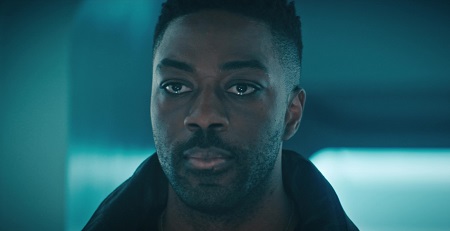
Earlier in the season, we saw Burnham advocate a compromise position, and But To Connect should have offered another opportunity to do so: building the weapon capable of destroying the DMA before attempting first contact. If the DMA then changes course and presents an active threat, it can be destroyed. And in addition, having the weapon in reserve while making first contact would be a valuable asset. If Unknown Species 10-C won’t see reason, the weapon could be a threat. If there’s no one there to negotiate with, the DMA could be destroyed. In short, the answer to the pretty basic problem that the episode posed isn’t “do one or the other,” it should have been “do both.” Build the weapon as a back-up while preparing for first contact.
If Discovery hadn’t insisted on themes of compromise across its last two seasons, I guess I’d give it a pass on this false choice. But in context, it seems to run counter to much of what the show has been trying to say for at least the last two years: that there are always solutions to or ways around these kinds of conflicts. The question of how to approach the DMA did not need to be a zero-sum game, and someone like Captain Burnham should have realised that – even if Book couldn’t.

Not for the first time, I’m left with a sense that Discovery’s writers and producers have a definite goal in mind; an endgame for the story and characters. But they haven’t figured out how to reach that finishing point in a clear and consistent manner, leaving this side of But To Connect feeling contrived.
On the flip side, the speeches that both Book and Burnham gave were very emotional, and I can’t fault the performances of either Sonequa Martin-Green or David Ajala. Both came across as two people trying to do what they genuinely believed was the right thing; conflicted because of what it would mean for their relationship, but determined to press ahead regardless. Although this wouldn’t be the way I would have chosen to handle either character, there can be no denying that the performances were exquisite.
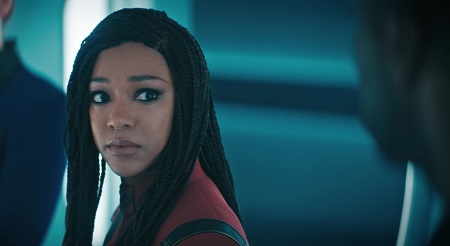
Also on this side of the story we had a muted role for President Rillak. Though she was on Burnham’s side – wanting to advocate for an attempt at peaceful contact – she chose to recuse herself from the debate, serving as a moderator only. I still get the sense that she has schemes in play – bringing Burnham along as an ally being one of the ways she tried to manipulate proceedings to get her way without being openly involved – but it was interesting to see her in a more centrist, unaffiliated role.
Among her ambitions from the diplomatic summit were showing the Federation as taking the lead in the fight against the DMA, but also opening initial channels to United Earth with a view to bringing the isolationist world back into the fold. We’ve seen a slight softening of Earth’s leadership since Burnham helped reunite Earth and Titan in Season 3, and it was nice to welcome back Phumzile Sitole as the newly-promoted General Ndoye. As a Trekkie, I want more than anything to see Earth rejoin the Federation – but only if it feels right. Earth shouldn’t be manipulated into coming back into the organisation, so this story beat will have to be handled delicately.

Ruon Tarka was perhaps the most surprising character in But To Connect. His self-assured cockiness was still there from his role in The Examples, but we got an idea of what could be driving him forward, and where his interest in the DMA may have come from. Stating that he wants to cross over into a parallel universe was certainly not something I expected – but at the same time it felt very familiar, and very Star Trek.
Tarka comes across as somewhat similar to Tolian Soran, the villain from Star Trek: Generations. Soran wanted to return to the Nexus – a paradise-like realm contained inside of an energy ribbon that periodically transited the galaxy. Tarka’s desire to enter the DMA and use its powerful controller to “punch through” to a parallel universe where he expected life to be better is at least somewhat comparable – and his willingness to break the rules and work against Starfleet shows the same kind of single-mindedness that Soran demonstrated.
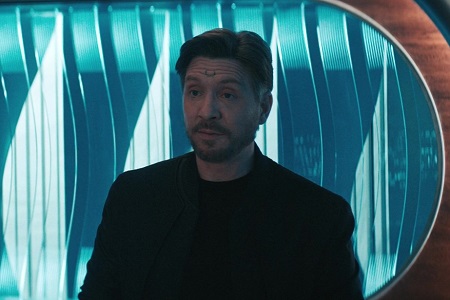
We’ll save for my theory post a full discussion of Tarka, his possible motivations, and potential destinations. But suffice to say this character turn has piqued my curiosity. There’s the potential to get a more complex presentation of a “mad scientist” character trope, one which gives him an understandable or even sympathetic motive for his actions. I don’t think we’re at that point yet, but I see potential in this storyline.
Shawn Doyle was wonderful in The Examples, making Tarka stand out as a different take on a character archetype that has appeared on a number of prior occasions in Star Trek. This amazing performance continued in But To Connect, and Doyle deserves a lot of credit for the way he brought the character to screen with complexity – especially given the relatively small amount of screen time that Tarka has had in the season so far.

As has happened several times already this season, though, Discovery quickly glossed over much of the actual work on the problems and puzzles posed by the DMA in order to get to the dramatic stand-off between Book and Burnham. Tarka’s weapon seemed to come out of nowhere, and although he’s clearly spent weeks or months of off-screen time working on it, in the episode itself it seemed to be a bolt from the blue; almost a deus ex machina solution to the threat posed by the DMA. As I’ve said on several occasions this season, the end result isn’t the problem – it’s that we as the audience really needed to see at least some of the process to get there, even if just by way of something like a montage.
In exactly the same way on the other side of the story, Zora’s discovery of the coordinates of the DMA’s origin was completely blitzed through in order to get to the story that the episode really wanted to tell. When it comes to the DMA, which is the season’s “big bad” at least thus far, Discovery has dedicated precious little time to actually dealing with it head-on, with much of the investigation happening off-screen. As the audience, we’ve been parachuted in just in time to see key moments: Stamets’ proto-wormhole theory, the DMA being an artificial construct, the DMA coming from outside of the galaxy, and now finally the discovery of its origin point. All of these points, so incredibly vital to the story of the DMA, feel like they’re scarcely even footnotes in a story which on the surface should be making more of them.
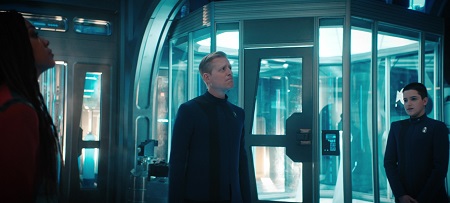
Before anyone jumps in to tell me off for missing the point: I get it. Discovery has other stories to tell, and wants to use this season in particular to look at issues surrounding trauma and grief. Practically all of the main characters seem to embody different responses to trauma: Stamets getting lost in his work, Culber desperately trying to help others even if doing so is at his own expense, Book’s journey through the stages of grief, and Tilly’s career switch all come from that same thematic place. And these individual, character-centric stories are absolutely worth telling. However, in a sci-fi series that also has the DMA as a major plotline, it feels that the first half of Season 4 has prioritised these character moments at the expense of this other major narrative. It should’ve been possible to balance the season’s story to give both appropriate weight and screen time – but Discovery has yet to find that balance.
So let’s tackle Zora next. The USS Discovery’s computer-AI-Sphere data hybrid has been developing slowly since Season 3, and until the very end of The Examples a couple of weeks ago felt like a relatively minor part of the season. Her transformation into basically an additional main character has been an interesting one, and this week was by far Zora’s biggest moment centre-stage. I got echoes of a number of past Star Trek stories – from The Ultimate Computer and The Measure of a Man through to Picard Season 1’s dealings with the synths and Data – in the way Zora was analysed and discussed by Dr Kovich, Dr Culber, Stamets, Adira, and Gray. It was an incredibly honest and frank discussion, one which absolutely embodied the spirit of Star Trek.
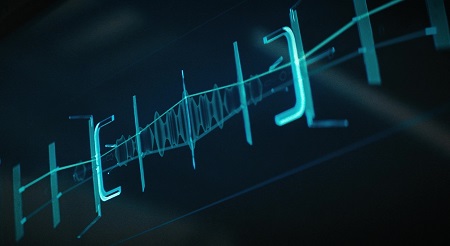
Through this side of the story, But To Connect gave us by far the best and most sympathetic presentation of Dr Kovich. I maintain that, based on his earlier appearances, some kind of Section 31 or spy role was a possibility – and maybe that was the original intention for the character when he was created in Season 3. In But To Connect, however, we saw Dr Kovich as a firm believer in the values and ideals of Starfleet and the Federation: determined to seek out new life, and to ensure that very different forms of life have the same rights as everyone else.
Stamets also shone on this side of the story, and the writing here showed off a complexity that the relatively short half-episode runtime could have hampered. Stamets’ attitude toward Zora’s newly developed sentience could have come across badly, making him out to be some kind of “AI-phobe,” in the vein of something like Picard Season 1’s Zhat Vash. However, the way Stamets was handled – aided greatly by a wonderful performance from Anthony Rapp – ensured that we could understand his reservations and concerns without seeing him as some kind of futuristic bigot.
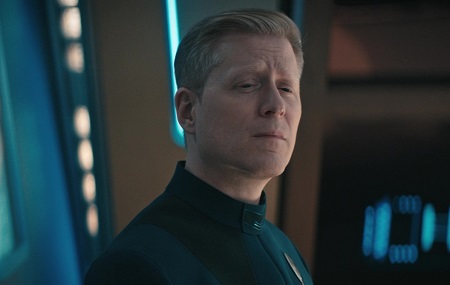
As in All Is Possible, Discovery succeeded at taking a complex argument and ensuring that the views on both sides were sensible and understandable, allowing true understanding and trust to be reached. Likewise this week, Stamets didn’t simply try to put his foot down and declare that the existence of Zora was some kind of horrible, insurmountable problem, and nor did Zora attack Stamets or try to shut down his concerns.
In an increasingly polarised political climate here in the west, where politicians and activists on all sides are increasingly dogmatic and unwilling to listen to opposing points of view, Discovery once again showed us how debate and discussion should be handled: calmly, maturely, and with mutual respect. This is one of the lessons from this season of the show: that we can’t simply write off points of view we disagree with, nor should we try to shut down or dismiss them. Listening is the first step toward understanding.
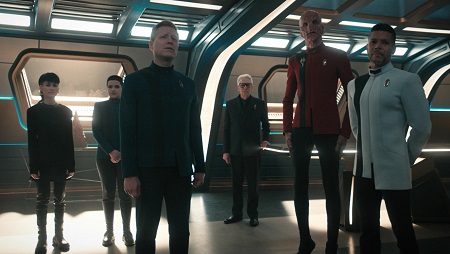
From my perspective as someone who’s non-binary, I felt there could be echoes of the real-world conversation surrounding transgender and non-binary folks in the way Zora’s movement toward acceptance was handled. There are many people who are dismissive of trans and non-binary people – something I sadly experienced firsthand recently in a conversation with someone I considered a friend. An unwillingness to listen and a desire to be dismissive of something we personally don’t understand is always going to be a temptation – but Stamets found that, by having a frank and honest conversation, his fears and concerns could be allayed.
There’s been a lot of debate around transgender and non-binary rights in recent years, and the issues of sex, gender, and gender identity have become highly politicised. Zora was struggling to find acceptance in But To Connect, and I felt that the show was perhaps drawing on the trans inclusion discussion for inspiration in this particular storyline. Speaking from a personal perspective, it isn’t easy to figure oneself out. To then present oneself to one’s friends only to be rejected is a horrible feeling – and I’m glad that Zora’s friends were able to remain on her side, even if they had questions about her at first.
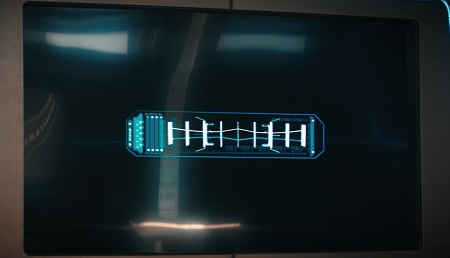
The Zora conversation also tackled the real-world issue of artificial intelligence and the growing impact of machine learning, algorithms, and AI on our daily lives. Star Trek has depicted “evil” AIs on several occasions, including in Season 2 of Discovery, so to take a break from that negative portrayal and to find a way to show AI in a positive light was a welcome change. I’m no longer convinced, for example, that we’ll see Zora go rogue or act against the crew’s wishes later in the season or in future stories; her status as a bona fide member of the crew feels settled.
Stamets was part of that, and voiced his concerns with eloquence before coming around to accepting Zora’s place in the crew. Dr Culber played a role too, as did Gray and Adira. It was very cathartic, after Stamets missed the entirety of Gray’s incorporation a few episodes ago, to see the two characters having the chance to interact. Gray’s future on the show is now uncertain following his departure with Guardian Xi bound for Trill, so it was even more important to give him and Stamets some small crumbs of screen time together.

In a very real sense, But To Connect felt like two distinct episodes haphazardly bolted together. In a longer season, both the conflict at the diplomatic summit and Zora’s moves toward sentience could have been explored while also giving more time to the likes of Tarka and his efforts to untangle the mysteries posed by the DMA. But because Discovery wanted to make a point – not a bad point, I concede – about Starfleet seeking out new life, we got both stories squashed down into the runtime of a single episode. Neither of these stories were bad, nor was the link between them, but the conflict at the summit in particular would have benefitted from additional development, and the incredibly minor side-story about Tarka and the DMA could have been fleshed out a lot more – as could Stamets, Adira, and Zora’s work to find the coordinates.
The similarities between the stories of Zora and the DMA would’ve still worked had they been longer or spread across two episodes, and I guess my big criticism of But To Connect isn’t that I hated or even disliked either, it’s that I would’ve liked to have seen a longer, perhaps slower-paced, version of them. Cutting the conflict between Book and Burnham – or finding a way to resolve it – would also have been a preference.

But To Connect told two stories about seeking out new life: the very core of Starfleet’s mission. Zora’s story was the better of the two; it had more nuance, better characterisation, and a truly sympathetic presentation of both sides of the discussion. It dealt with incredibly deep and complex themes in an understandable way, giving rise to a conclusion that felt natural, but most importantly that felt earned.
The diplomatic summit, meanwhile, took what could have been a similar setup but presented it as a false “either-or” choice – a choice that, I would argue, felt unnecessary and thus contrived. Its conclusion, instead of being one that promoted understanding and dialogue, ended with one side claiming total victory and the other suffering defeat. This laid the groundwork for Book and Tarka’s rebellion – stealing a spore drive prototype and flying away to attack the DMA. That ending may have been a natural or inescapable one given the setup, but it didn’t need to be – and it seems to run counter to some very timely and important allegories that Discovery has tried to include this season.
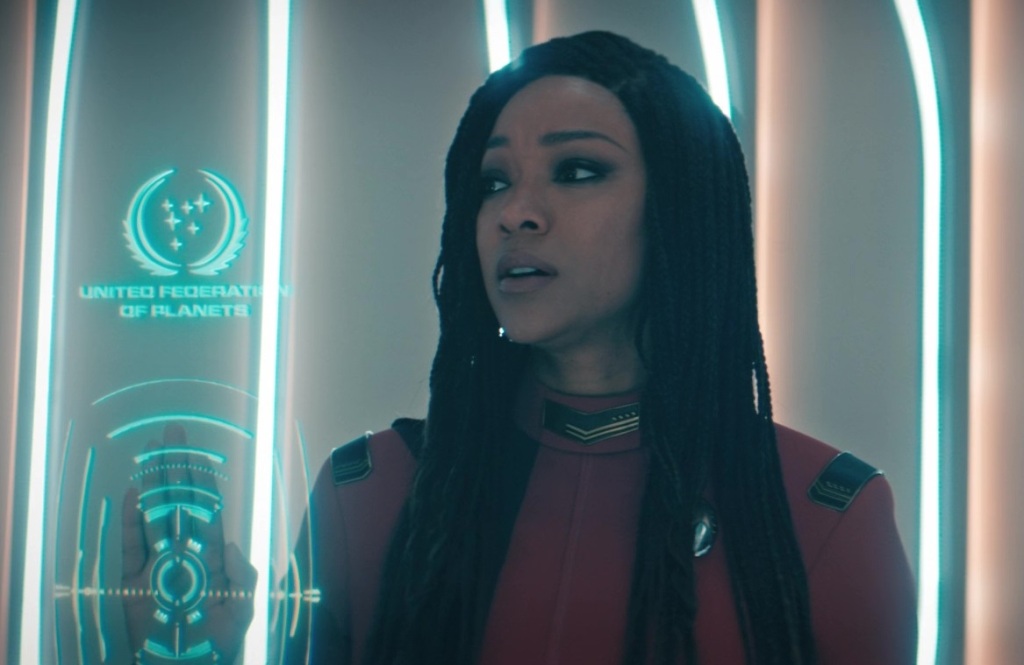
A few scattered final thoughts: Discovery seems to be going down the route of some of the ’80s Star Trek films by depicting interesting-looking background aliens… then giving them nothing to do nor even naming them. It would be nice to learn more about some of the galaxy’s races, but just dropping them in the background doesn’t feel like a particularly good way to handle things. The music in But To Connect was probably the best of the season so far, and the score used during the voting scenes in particular was incredibly tense – perfectly complimenting what was happening on screen.
Why does Burnham get a vote? I can understand why each Federation member world might get an individual vote, but giving everyone present the chance to vote could disproportionately favour one side. It feels like it was there for another moment of drama rather than because it makes sense in context.
We saw a full-blooded Cardassian, a Ferengi, and several other familiar races – including one who may be a Xindi. Missing from the summit, however, were races like the Klingons and factions like the Dominion. It’s possible that there have been major structural changes to those governments, or that diplomatic relations with the Federation are poor. Discovery may also be avoiding their use with a view to bringing them back in a future story – or to give room for the likes of Picard or Strange New Worlds to include these factions.

Stamets flipping the issue of trust onto Zora was a clever one, and a great rhetorical way to begin to bring that argument to a close. Dr Kovich’s line that Stamets could have been reassigned if he couldn’t work with Zora was clever – but then who would have operated the Spore Drive? Saru and T’Rina make an adorable couple, and although I wouldn’t consider either Doug Jones or Tara Rosling to be “old,” it was still sweet to see Discovery giving screen time to a burgeoning romance between two people who aren’t 25 any more!
So I think that’s about all I have to say for now. Stay tuned, because later in the week I’ll be writing up my theories for the second half of the season. It’s only six weeks, but I really can’t wait to find out what happens next! The DMA and Unknown Species 10-C still present wonderful mysteries, and although my head says what we’ll ultimately get will be something brand-new to the franchise, my heart is still hopeful that there’ll be some kind of big connection or callback to a past iteration of Star Trek!
Star Trek: Discovery Season 4 is available to stream now on Paramount+ in the United States, Scandinavia, Latin America, and Australia. The show is on Pluto TV in the UK, France, Germany, Italy, and other parts of Western Europe at 9pm on Fridays and Saturdays. Individual episodes or the full season can be purchased on iTunes, Amazon Video, and possibly other platforms in the UK, parts of Europe, and select other countries. The Star Trek franchise – including Discovery and all other properties mentioned above – is the copyright of ViacomCBS. This article contains the thoughts and opinions of one person only and is not intended to cause any offence.

